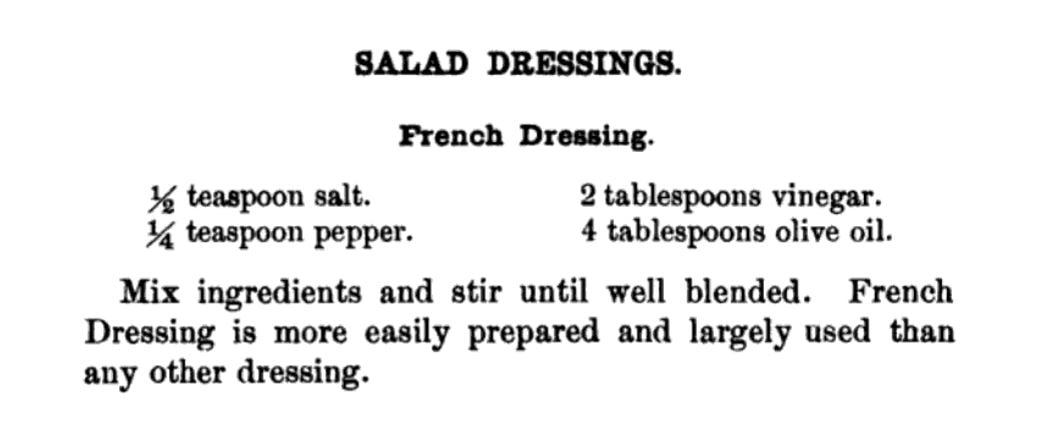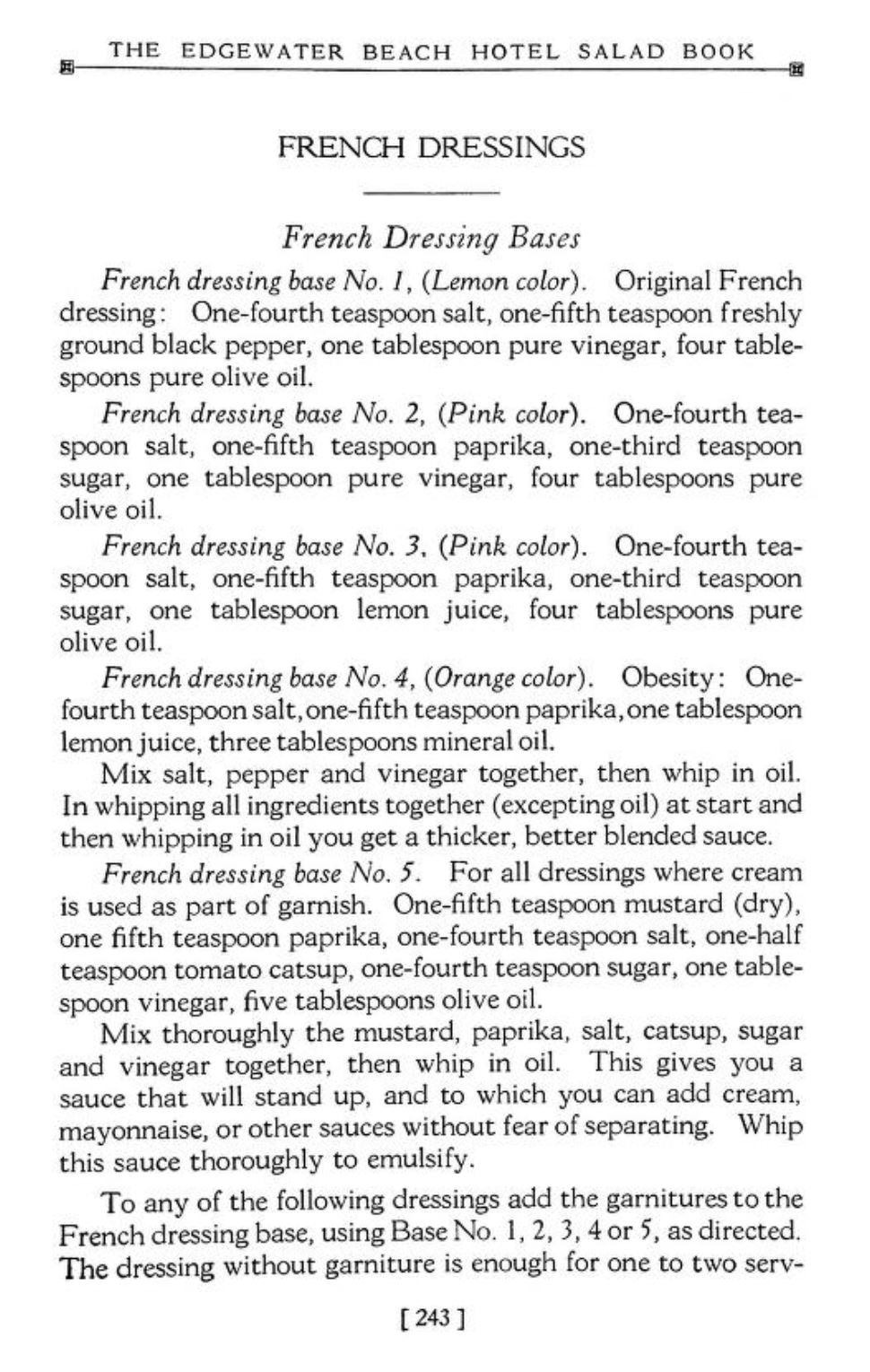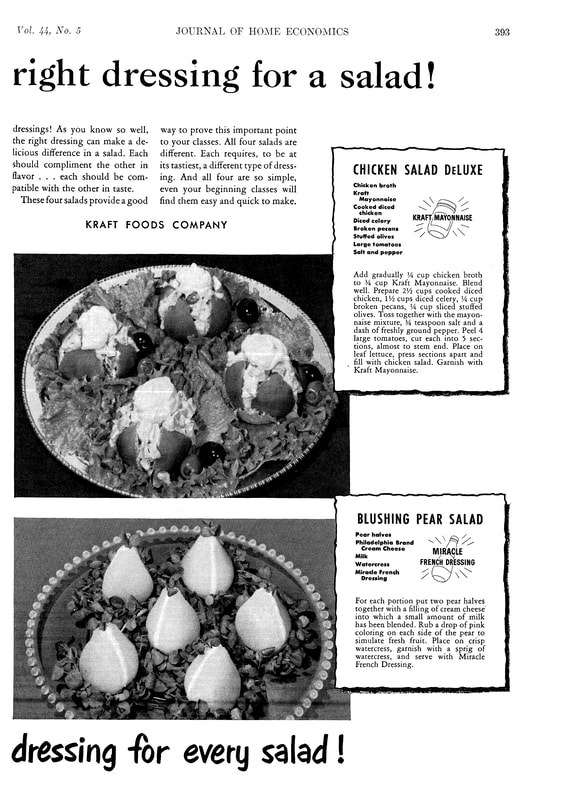|
The Food and Drug Administration recently announced that it would be de-regulating French Dressing. And while people have certainly questioned why we A) regulated French Dressing in the first place and B) are bothering to de-regulate it now, much of the real story behind this de-regulation is being lost, and it's intimately tied to the history of French Dressing.
A lot of people like to claim that French Dressing is not actually French. And if you're defining French Dressing as the tangy, gloppy, red stuff pretty much no one makes from scratch anymore, you'd be right. But the devil is in the details, and even the New York Times has missed this little bit of nuance. This Times article, published before the final de-regulation went into place, notes, "The lengthy and legalistic regulations for French dressing require that it contain vegetable oil and an acid, like vinegar or lemon or lime juice. It also lists other ingredients that are acceptable but not required, such as salt, spices and tomato paste." (emphasis mine) What's that? The original definition of French Dressing, according to the FDA, was essentially a vinaigrette? What could be more French than that? In fact, that is, indeed, how "French dressing" was defined for decades. Look at any cookbook published before 1960 and nearly every reference to "French dressing" will mean vinaigrette. Many a vintage food enthusiast has been tripped up by this confusion, but it's our use of the term that has changed, not the dressing. Take, for instance, our old friend Fannie Farmer. In her 1896 Boston Cooking School Cookbook (the first and original Fannie Farmer Cookbook), the section on Salad Dressings begins with French Dressing, which calls for simply oil, vinegar, salt, and pepper.
She's not the only one. I've found references in hundreds of cookbooks up until the 1950s and '60s and even a few in the 1970s where "French dressing" continued to mean vinaigrette. You can usually tell by the recipe - composed salads of vegetables are the most common. If a recipe for "French dressing" is not included, and no brand name is mentioned, it's almost certainly a vinaigrette. So what happened?
I've managed to track down the original 1950 FDA Standard of Identity for mayonnaise, French dressing, and salad dressing. In it, the three condiments are considered together and are the only dressings identified, likely because few if any other dressings were being commercially produced. Although the term "salad dressing" has been extremely confusing to many modern journalists, it is clearly noted in the 1950 standard of identity of being a semi-solid dressing with a cooked component - in short, boiled dressing. The closest most Americans get today is "Miracle Whip," which is, in fact, a combination of mayonnaise and boiled dressing. Generic brands are often called just "salad dressing" because it was often used to bind together salads like chicken, egg, crab, and ham salad, and also often used with coleslaw. So it makes perfect sense that "French dressing" would be the designated term for poured dressings designed to be eaten with cold lettuce and vegetables - i.e. what we consider salad today. People have wondered why we needed to regulate salad dressings, but there is one very important distinction in the 1950 rule - it prohibits the use of mineral oil in all three. Mineral oil, which is a non-digestible petroleum product (i.e. it has a laxative effect), and which is colorless and odorless, was a popular substitute for vegetable oil during World War II by dieters in the mid-20th century. I collect vintage diet cookbooks and it shows up frequently in early 20th century ones, especially as a substitute for salad dressings. Mineral oil is also extremely cheap when compared with vegetable oils, and it would be easy for unscrupulous food manufacturers to use it to replace the edible stuff, so the FDA was right to ensure that it did not end up in peoples' food. Mineral oil is sometimes still used today as an over-the-counter laxative, but can have serious health complications if aspirated. There were several subsequent addenda to the standard of identity, but most were about the inclusion of artificial ingredients or thickeners, with no mention of any ingredients that might change the flavor or context of what was essentially a regulation for vinaigrette until 1974, when the discussion centered around the use of artificial colors instead of paprika to change the color of the dressing. The FDA ruled that "French dressing may contain any safe and suitable color additives that will impart the color traditionally expected." So here we see that by the 1970s, the standard of identity hadn't actually changed much, but the terminology had. "French dressing" went from the name of any vinaigrette, to a specific style of salad dressing containing paprika (and/or tomato). When people started adding paprika is unclear, but it was probably sometime around the turn of the 20th century, when home economists began to put more and more emphasis on presentation and color. A lively reddish orange dressing was probably preferable to a nearly-clear one. In 2000, the LA Times made an admirable effort to track the early 20th century chronology of the orange recipes. By the 1920s, leafy and fruit salads began to overtake the heavier mayonnaise and boiled dressing combinations of meat and nuts. As the willowy figure of the Gibson Girl gave way to the boyish silhouette of the flapper, women were increasingly concerned about their weight, and salads were seen as an elegant solution.
The recipes pictured above are from The Edgewater Beach Hotel Salad Book, published in 1928 (Patreon patrons already got a preview of this cookbook earlier in the week!). The Edgewater Beach Hotel was a fashionable resort on the Chicago waterfront which became known for its catering and restaurant, and in particular its elegant salads. You'll note that several French Dressing recipes are outlined (they are also introduced first in the book), and are organized by color. "No. 4 (Orange Color)" has the note "obesity" not because it would make you fat - quite the opposite - its use of mineral oil was designed for people on diets. Although the fifth recipe does not note a color, it does contain both paprika and tomato "catsup," and all but the original and "obesity" recipes contain sugar. An increase in the consumption of sweets in the early 20th century is often attributed to the Temperance movement and later Prohibition.
By the 1950s, recipes for "French Dressing" that doctored up the original vinaigrette with paprika, chili sauce, tomato ketchup, and even tomato soup abounded. My 1956 edition of The Joy Of Cooking has over three pages of variations on French Dressing. Hilariously, it also includes a "Vinaigrette Dressing or Sauce," which is essentially the oil and vinegar mixture, but with additions of finely chopped pimento, cucumber pickle, green pepper, parsley, and chives or onion, to be served either cold or hot. All the other vinaigrettes have the moniker "French dressing." A Google Books search reveals an undated but aptly titled "Random Recipes," which seems to date from approximately mid-century, and which includes a recipe for Tomato French Dressing calling for the use of Campbell's tomato soup, and "Florida 'French Dressing'," containing minute amounts of paprika, but generous citrus juices and a hint of sugar. So maybe people were making their own sweetly orange French dressing at home after all?
There is some debate as to who actually "invented" the orange stuff, but while Teresa Marzetti may have helped popularize it, the general consensus is the Milani brand, which started selling its orange take in 1938 (or the 1920s, depending who you ask - I haven't found a definitive answer one way or the other), was the first to commercially produce it. Confusingly, the official Milani name for their dressing is "1890 French Dressing." The internet has revealed no clues as to whether or not the recipe actually dates back that far, but a 1947 New York Times article claims "On the shelves at Gimbels you'll find 1890 French dressing, manufactured by Louis Milani Foods. It is made, the company says, according to a recipe that originated in Paris at that time and was brought to this country after the fall of France. This slightly sweet preparation, which contains a generous amount of tomatoes, costs 29 cents for eight ounces." This seems like a marketing ploy rather than the truth, but who knows for sure?
In 1925, the Kraft Cheese Company did sign a contract with the Milani Company to become their exclusive distributor. At least, that's what a snippet view of 1928 New York Stock Exchange listing statements tells me. As early as 1931 Kraft was manufacturing French Dressing under their name, and by the 1940s it had also used the Miracle Whip brand name to create Miracle French Dressing - which had just a "leetle" hint of garlic.
One snippet reference in the 1934 edition of "The Glass Packer" notes, "Differing from Kraft French Dressing, Miracle French is a thin dressing in which the oil and vinegar separate in the bottle, and which must be shaken immediately before using." Miracle French was contrasted often in advertising with classic Kraft French as being zestier, which may have led to the development in the 1960s of Kraft's Catalina dressing, a thinner, spicier, orange-er French dressing.
In fact, as featured in this undated magazine advertisement, Kraft at one point had several varieties of French Dressing including actual vinaigrettes like "Oil & Vinegar," and "Kraft Italian" alongside Catalina, Miracle French, Casino, Creamy Kraft French, and Low Calorie dressing, which also looks like French dressing. What you may notice is that the "Creamy Kraft French" looks suspiciously like most of the gloppy orange stuff you see on shelves today, and which generally doesn't resemble a thin, runny, paprika/tomato-red dressing that dominates the rest of this lineup.
"Spicy" Catalina dressing was likely introduced sometime around 1960 (although the name wasn't trademarked until 1962). Kraft Casino dressing (even more garlicky) was trademarked for both cheese and French dressing in 1951, but by the 1970s appears to have left the lineup. Here are a few fun advertisements that compare some of the Kraft French dressings:
Of course by the 1950s other dressing manufacturers besides Kraft were getting in on the salad dressing game, including modern holdouts like:
Although many people in the United States grew up eating the creamy orange version of French Dressing, it's mostly vilified today (aside from a few enthusiasts). Which is too bad. As a dyed-in-the-wool ranch lover (hello, Midwestern upbringing - have you tried ranch on pizza?), I try not to judge peoples' food preferences. And I have to admit that while I've come to enjoy homemade Thousand Island dressing, I can't say that I've ever actually had the orange French! Of any stripe, creamy, spicy, or otherwise. I'm much more likely to use homemade vinaigrette from everything from lentil, bean, and potato salads to leafy greens. So to that end, let's close with a little poll. Now that you know the history of French Dressing, do you have a favorite? Tell us why in the comments!
The Food Historian blog is supported by patrons on Patreon! Patrons help keep blog posts like this one free and available to the public. Join us for awesome members-only content like free digitized cookbooks from my personal collection, e-newsletter, and even snail mail from time to time! Don't like Patreon? Join with an annual membership below, or just leave a tip!
1 Comment
Jared
4/29/2023 01:12:00 pm
This is not correct at all….. it was made in Pittsburgh not Paris….. idk how a website that’s suppose to give history gets that wrong….
Reply
Your comment will be posted after it is approved.
Leave a Reply. |
AuthorSarah Wassberg Johnson has an MA in Public History from the University at Albany and studies early 20th century food history. Archives
July 2024
Categories
All
|








 RSS Feed
RSS Feed